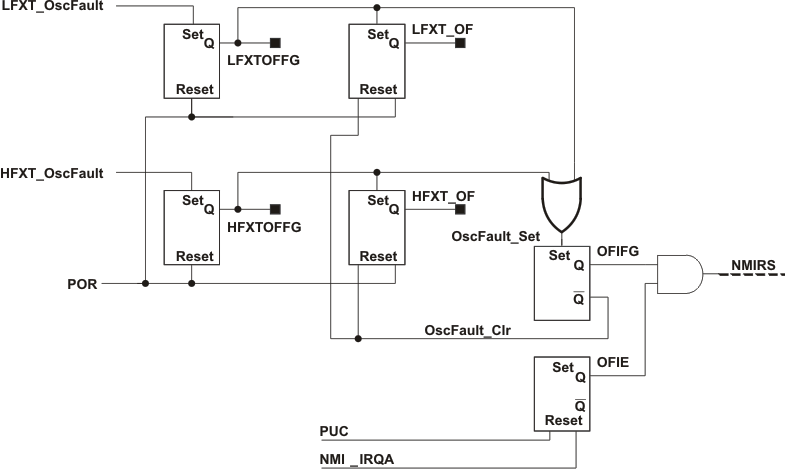SLAU367P October 2012 – April 2020 MSP430FR5041 , MSP430FR5043 , MSP430FR50431 , MSP430FR5847 , MSP430FR58471 , MSP430FR5848 , MSP430FR5849 , MSP430FR5857 , MSP430FR5858 , MSP430FR5859 , MSP430FR5867 , MSP430FR58671 , MSP430FR5868 , MSP430FR5869 , MSP430FR5870 , MSP430FR5872 , MSP430FR58721 , MSP430FR5887 , MSP430FR5888 , MSP430FR5889 , MSP430FR58891 , MSP430FR5922 , MSP430FR59221 , MSP430FR5947 , MSP430FR59471 , MSP430FR5948 , MSP430FR5949 , MSP430FR5957 , MSP430FR5958 , MSP430FR5959 , MSP430FR5962 , MSP430FR5964 , MSP430FR5967 , MSP430FR5968 , MSP430FR5969 , MSP430FR5969-SP , MSP430FR59691 , MSP430FR5970 , MSP430FR5972 , MSP430FR59721 , MSP430FR5986 , MSP430FR5987 , MSP430FR5988 , MSP430FR5989 , MSP430FR5989-EP , MSP430FR59891 , MSP430FR5992 , MSP430FR5994 , MSP430FR59941 , MSP430FR6005 , MSP430FR6007 , MSP430FR6035 , MSP430FR6037 , MSP430FR60371 , MSP430FR6041 , MSP430FR6043 , MSP430FR60431 , MSP430FR6045 , MSP430FR6047 , MSP430FR60471 , MSP430FR6820 , MSP430FR6822 , MSP430FR68221 , MSP430FR6870 , MSP430FR6872 , MSP430FR68721 , MSP430FR6877 , MSP430FR6879 , MSP430FR68791 , MSP430FR6887 , MSP430FR6888 , MSP430FR6889 , MSP430FR68891 , MSP430FR6920 , MSP430FR6922 , MSP430FR69221 , MSP430FR6927 , MSP430FR69271 , MSP430FR6928 , MSP430FR6970 , MSP430FR6972 , MSP430FR69721 , MSP430FR6977 , MSP430FR6979 , MSP430FR69791 , MSP430FR6987 , MSP430FR6988 , MSP430FR6989 , MSP430FR69891
3.2.8 CS Module Fail-Safe Operation
The CS module incorporates an oscillator-fault fail-safe feature. This feature detects an oscillator fault for LFXT and HFXT as shown in Figure 3-3. The available fault conditions are:
- Low-frequency oscillator fault (LFXTOFFG) for LFXT
- High-frequency oscillator fault (HFXTOFFG) for HFXT
- External clock signal faults for all bypass modes; that is, LFXTBYPASS = 1 or HFXTBYPASS = 1
The crystal oscillator fault bits LFXTOFFG and HFXTOFFG are set if the corresponding crystal oscillator is turned on and not operating properly. Once set, the fault bits remain set until reset in software, even if the fault condition no longer exists. If the user clears the fault bits and the fault condition still exists, the fault bits are automatically set; otherwise, they remain cleared.
The OFIFG oscillator-fault interrupt flag is set and latched at POR or when any oscillator fault (LFXTOFFG or HFXTOFFG) is detected. When OFIFG is set and OFIE is set, the OFIFG requests a user NMI. When the interrupt is granted, the OFIE is not reset automatically as it is in previous MSP430 families. It is no longer required to reset the OFIE. NMI entry and exit circuitry removes this requirement. The OFIFG flag must be cleared by software. The source of the fault can be identified by checking the individual fault bits.
If LFXT is sourcing any system clock (ACLK, MCLK, or SMCLK) and a fault is detected, the system clock is automatically switched to LFMODCLK for its clock source. The LFXT fault logic works in all power modes, including LPM3.5. Similarly, if HFXT is sourcing MCLK or SMCLK, and a fault is detected, the system clock is automatically switched to MODCLK for its clock source. By default, the HFXT fault logic works in all power modes except LPM3.5 or LPM4.5, because high-frequency operation in these modes is not supported. The fail-safe logic does not change the respective SELA, SELM, and SELS bit settings. The fail-safe mechanism behaves the same in normal and bypass modes. Reconfigure the CS settings and follow the instructions in Section 1.4.3 after wakeup from LPM3.5 or LPM4.5, because all CS registers are reset to default values.
 Figure 3-3 Oscillator Fault Logic
Figure 3-3 Oscillator Fault Logic NOTE
Fault conditions
LFXT_OscFault: When the fault detection logic is enabled (ENLFXTD = 1), this signal is set after the LFXT oscillator has stopped operation and is cleared after operation resumes. The fault condition causes LFXTOFFG to be set and remain set. If the user clears LFXTOFFG and the fault condition still exists, LFXTOFFG remains set.
HFXT_OscFault: When the fault detection logic is enabled (ENHFXTD = 1), this signal is set after the HFXT oscillator has stopped operation and is cleared after operation resumes. The fault condition causes HFXTOFFG to be set and remain set. If the user clears HFXTOFFG and the fault condition still exists, HFXTOFFG remains set.
NOTE
Fault logic
As long as a fault condition still exists, the OFIFG remains set. The application must take special care when clearing the OFIFG signal. If no fault condition remains when the OFIFG signal is cleared, the clock logic switches back to the original user settings before the fault condition.
NOTE
The LFXT startup includes a counter that ensures that 1024 valid clock cycles have passed before LFXT_OscFault signal is cleared. A valid cycle is any cycle that meets the frequency requirement (fFault,LF) as outlined in the device specific data sheet. Any crystal fault restarts the counter. It is recommended that the counter always be enabled, however the counter can be disabled by clearing ENSTFCNT1.
Similarly, HFXT startup also includes a counter that ensures that 1024 valid clock cycles have passed before HFXT_OscFault signal is cleared. This counter can be disabled by clearing ENSTFCNT2.
The disabling of the counters is valid for bypass and normal modes of operation.